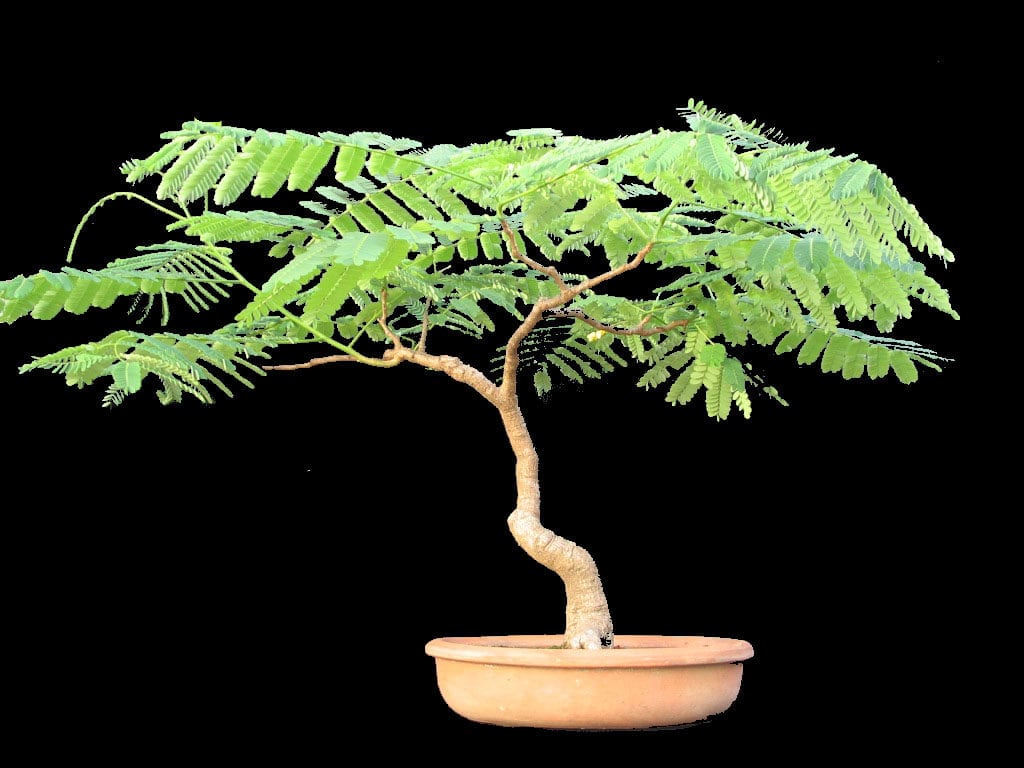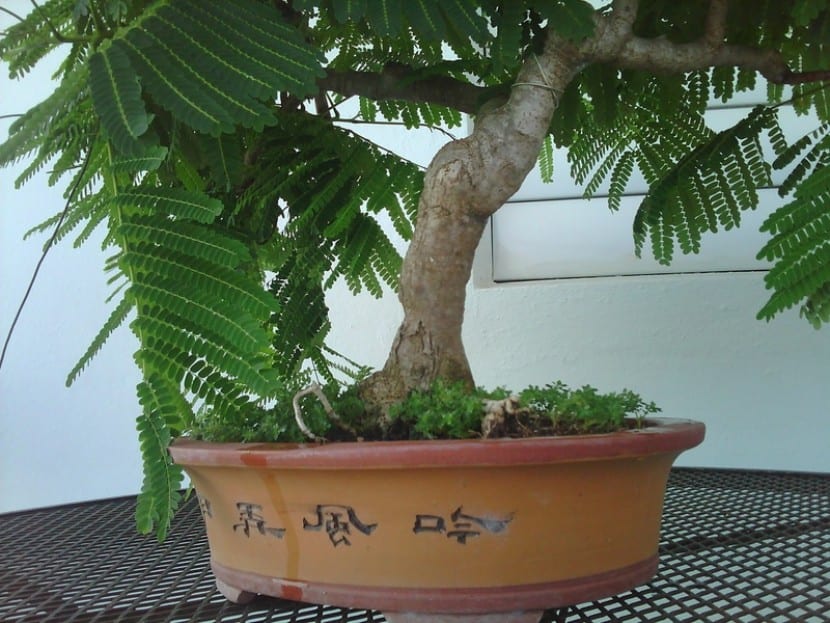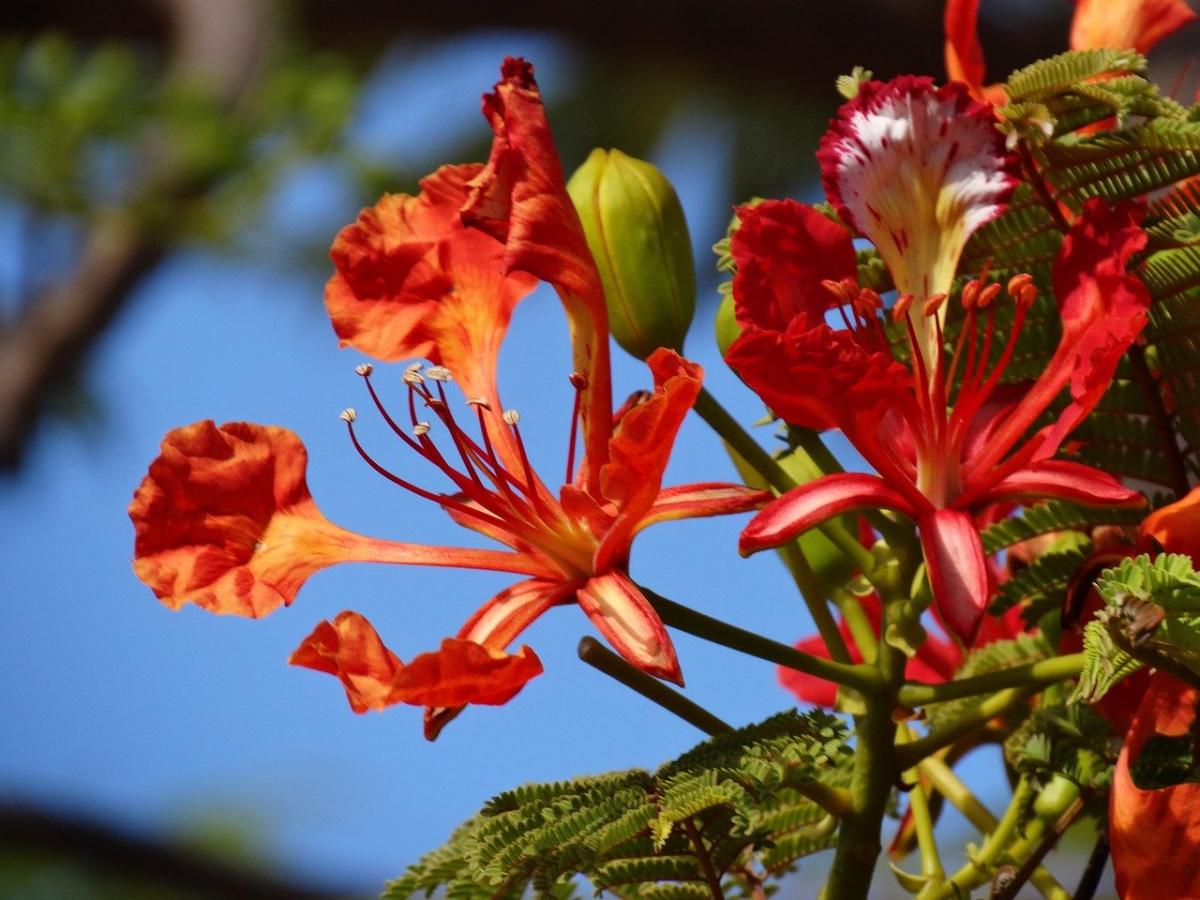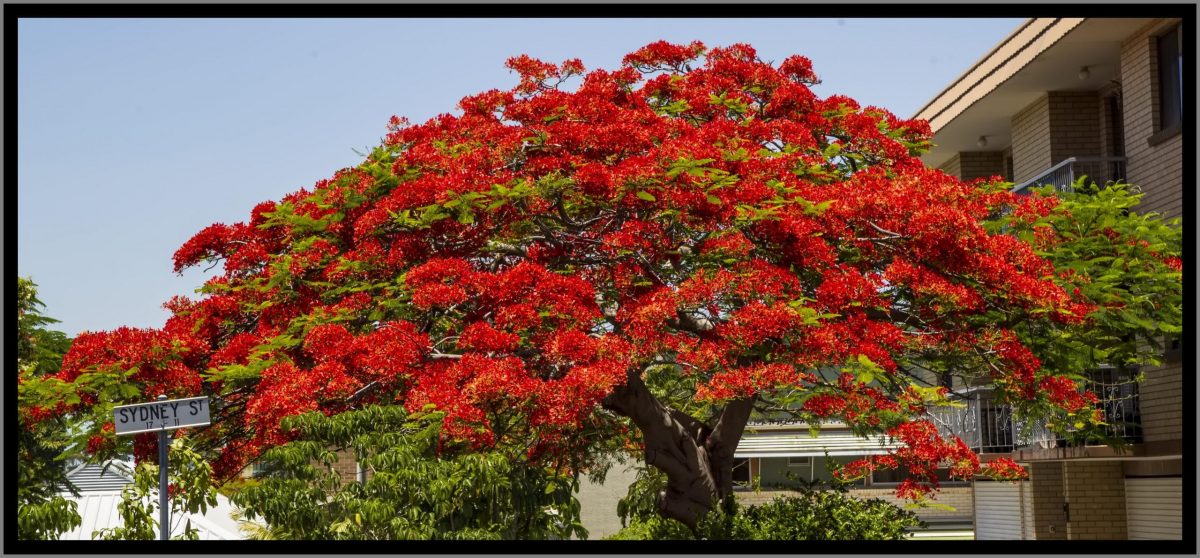
Image - Blond Bonsai
Would you like to have a flamboyant but you don't have enough space for it to develop well? Well, I have the perfect solution for you: work it like bonsai. I'm not going to fool you: it is not a particularly popular tree in this world of miniature trees, but… it is used.
The question is: how do they do it? How can we get a flamboyant bonsai?
How to make a bonsai with a flamboyan tree?
The first and foremost thing to do is, of course, buy a flamboyant. But we will have a little problem: flamboyans that are sold in nurseries normally already measure 2-3m and have a trunk thickness of 3-4cm, that is, they are garden trees. They could be lowered in height, but the cut it would fit would make the future bonsai look a bit bad.
To avoid this, I recommend more to reproduce it by seeds, cuttings or air layering. In these last two cases, the branch must be 1-2cm thick. If you do not know how to do it, in this other article dedicated to this magnificent tree we will explain step by step how to proceed. Once we have our future bonsai, it will be time to work on it. But how? Well, so as not to complicate us too much, we will give it a natural style, that is, as it would be seen in nature. So more or less:
The crown, as we can see, is parasolate, the trunk slightly sloping and with 2-3 main branches. Well, this is what we have to achieve. To make it, It is essential that while it is young (it would be, more or less, at the second year of age if we have taken it from seed) we remove the first two-three leaves that grow from what will be the main branch. Thus, we will force you to remove new branches.
From then on, what we will do is trim the branches so that the tree does not grow so much in height, letting 4-6 shoots grow - leaves and / or secondary branches-, and removing 2-4. All this will have to be done by having the tree planted in an increasingly large pot (40-45cm in diameter), until the trunk is at least 2cm thick. Little by little, we will see that our future bonsai is taking shape.
After a year, we can start talking about transplants to shallow pots and root pruning. Both tasks have to be done on the same day, in early spring. They seem complicated, but they are not so complicated. It must be done in the following way:
- Remove the tree from the pot.
- Remove the substrate, as much as you can, leaving the roots clean.
- Trim them a bit (no more than 3cm).
- Plant your flamboyant in a 20cm high pot, with a very porous substrate (it is advisable to use akadama, but you can use black peat mixed with perlite).
- Water.
The following year, we will have to proceed in the same way, but this time, trimming the roots 5cm and planting the tree in a shallow pot.
Then in the third year, can be planted in a bonsai tray, giving it a shakkan (slightly sloping), or chokkan (formal vertical) style.

Image - Bonsai in the tropics
And ready. Then it will be a matter of maintaining the style by small pruning, both branches and roots, so that the tree can look spectacular in its bonsai pot.
How to care for a flamboyan bonsai?
To take care of your bonsai, we recommend the following:
- Location: whenever possible, you have to keep it outside, in a sunny area. But if there is frost in your area, keep it indoors during the winter, in a room without drafts.
- Substratum: it is highly recommended to mix 70% akadama (on sale here) with 30% kiryuzuna. Now, a substrate for bonsai will also serve you (for sale here).
- Irrigation: in principle it should be frequent, especially during the hottest and driest months of the year. It does not withstand the drought, so that about two or even three weekly waterings will do well in summer. The rest of the year you will have to water less.
- Subscriber: Since the flamboyan bonsai has a hard time flowering, it is advisable to use a fertilizer that is rich in phosphorus.
- Transplant: it has to be transplanted every 2 years, when spring has established.
- Pruning: it is advisable to prune in autumn, but you only have to do small pruning; that is, you have to cut only tender and / or semi-woody parts, so that it can heal well and look as natural as possible.
- Rusticity: should not be exposed to temperatures below 5ºC.
What to do so that the flamboyan bonsai gives a lot of flowers?
A very common problem that occurs in the flamboyan worked as bonsai is that it either does not bloom, or produces few flowers. And it is that this is a tree that in order to flourish in conditions it needs, first, to grow at its own pace, without being pruned by humans, and secondly, space and nutrients to develop normally and, thus, have enough energy and means to produce flowers and seeds.
Of course, a bonsai is a plant that is pruned every year, since it is maintained with a certain height and style. The only thing that can be done to make it bloom is to fertilize it with a fertilizer that stimulates flowering; that is, one that is rich in phosphorus, since it is used for the production of flowers, such as this one here.
However, it is important to follow the instructions for use. An excess of fertilizer is very harmful to the flamboyan bonsai (and actually for any plant), since it burns the roots and causes them to weaken causing irreversible damage. But if you take the right dose and with the frequency that the manufacturer recommends, then you can get it to flourish.
When do flamboyants bloom?

Even if we fertilize it, the flamboyan bonsai will take time to bloom. This is normal and should not worry us too much. And is that In a natural state, a flamboyan can take up to 10 years from when the seed germinated. Therefore, if you work as bonsai you will need more time.
So if we provide you with a series of care; that is, we water it and we fertilize it periodically, we will have a plant that, yes, will need time to bloom, but once it does, it will surely bloom spring after spring.
So, do you dare to make a flamboyan bonsai?

Thank you very much, Monica, I have bought seeds (also from other trees and plants) and this article is wonderful. At the moment I'm trying to germinate the seeds (I soaked them for a couple of days and then transferred them to a container of yogurt) and trying a lemon tree 😉 A hug.
I'm glad it's useful to you, Camelia 🙂. Good luck with those seeds!
I am trying three flamboyan trees
Good luck, Vivian 🙂
I like everything I have read, many years ago I planted my framboyan trees collected from the little ones that are born at the base of the red framboyan trees because the yellow one never made it, then I did it for 17 years and perhaps because I did not have enough nutrients, it I died. I got a very pretty root ball, I think it's called that big, I also did the scraping of the trunk that gives the appearance of regenerating the little tree with knots in it, which if it never flowered I see, it's very complicated
However, I am going to take up again with more seriousness and possibilities to make my bomsai and I have or have achieved framboyanes from seeds and also from yellow I have managed to germinate the seeds even much easier than the red itself, I only lack the blue or jacaranda
Hi carmen.
Yes, sometimes it's hard for it to bloom.
The jacaranda is not a flamboyan. It is another type of tree 🙂 . Here Do you have information about him?
A greeting.
Excellent article. I collected three newly germinated seedlings at the foot of a larger flamboyan. They had three twigs each and still had the mother leaf at the foot of the trunk. I have now been 6 weeks with all three planted in an oval (30 cm) plastic bonsai material and they are developing very well. The question I have is whether to leave them for the first two years at three in the same pot (forest style) or to make them independent.
I read that they are the type of plants that take all the nutrient from the soil. But I don't know if the law of sharks applies (only the strongest survives in the belly). I appreciate your help.
Advice for those who want to have a plant from seed .. it is easier to collect them at the foot of large plants at the beginning of spring .. they sprout a lot ...
Hello Oscar.
To get bonsai, it is better that they are planted in large individual pots, about 40cm in diameter and 45-50cm deep. In this way, they will be able to fatten the trunk much earlier (starting already the second year).
Regarding that they absorb all nutrients from the soil, it is not like that, but they do need a lot. Hence, it is highly recommended to pay them during the warm months.
a greeting
Thank you for your kind and timely response Monica. I'll plant them individually then. Greetings.
Thanks to you, Oscar. That you enjoy your flamboyant 🙂.
I will send you the photo of the three flamboyant as I have them now ... and then when I passed them each one to its pot. Here in Venezuela (Eastern Region) The climate is doing very well for these plants ... and they have grown very fast, despite the fact that on the side where I have them (in front of my apartment) they get sun only in the morning hours for this time of year.
Hello Oscar.
They sure are great 🙂. When the weather is good ... plants grow great.
A greeting.
One question ... will I be able to transplant, once I have the tree big enough with a blue one?
Hi Kordh.
Sorry, I didn't understand your question well 🙁. I answer you and if that is not what you wanted to know, please, write us again.
Blue flamboyants do not exist. From what I understand, the Jacaranda mimosifolia is called a blue flamboyant, and not the Delonix regia. Being from different botanical families, branches of one cannot be grafted onto another.
In the garden it is not a good idea that they grow together, since the flamboyant is a tree that does not let anything grow underneath due to the ethylene gas emitted by its leaves (it is an allelopathic plant that is called).
A greeting.
Hello Monica. Here again. Following your recommendation, plant the three flamboyants in their own pot. At that time I did not have pots as large as recommended. I had one of 35cm others of 20 and 15 ... so I planted them ... Naturally the one with the largest pot has had more development, but they are all very beautiful. I have only noticed that sometimes some branches do not unfold the leaves, and they remain twisted (with the lightest part facing up). I water them according to the weather, if it is very sunny and hot, I water them every 2 days, and every 4 days if there are rainy days. I have them in an area where they only get direct sun in the mornings and the rest of the day only the glare. Do you think that under that condition they can develop quietly? In the afternoons, despite not receiving direct sunlight, their leaves are seen in their best greenness… By the way, I already named them… Athos, Porthos and Aramis…. Hahahaha ... Greetings
Hello Oscar.
Well, just this year I have done an »experiment» and I have left some flamboyant seedlings in semi-shade. They receive direct light only in the afternoon, and the truth is that they are growing well. Of course, they receive more light than shadow, since otherwise the leaves do not finish developing well (what you say happens to them, that they do not finish unfolding).
Even so, if they have more green leaves and they grow well, I believe that your seedlings will end up adapting to those conditions.
A greeting.
Excellent article, when do you recommend pruning the branches? I understand that before spring but I want to confirm. Greetings
Hi Rolando.
I'm glad that you liked it.
Yes, indeed, a little before spring you can prune.
A greeting.
I live in Orlando, Florida, USA. I have a 6-7 year old flamboyan that was gifted to me in a 12 inch pot when it was about 10 inches tall. It was poorly maintained for 3-5 years and last year I took it to a bonsai expert who pruned it and transplanted it into a larger pot. Normally when I fertilize it in spring it grows a lot and I prune it so that it maintains the traditional shape of the crown.
I have it on the balcony of my building that faces south and has direct light most of the day. For seasons I have fed it some times more than others but usually I keep it well watered so that the leaves do not close before dark. In summer there are times when I have to water it twice a day.
His trunk is now about 1 1/2 inch in circumference and he is about 28 inches tall. The cup is approximately 30 inches wide. As it has not been too cold, it has kept its leaves quite well, but some branches have few leaves. This spring I plan to prune it and change it pot but I don't know what to do to make it bloom. I appreciate your recommendation.
(Sorry for the lack of so many accents.)
Hi Nylda.
Flamboyant made bonsai has a hard time blooming. You have to pay it every year, keep it well watered, give it sunlight, and yet sometimes it may not bloom for 10 years or more.
It is a matter of patience.
Hopefully and give her flowers soon.
Thanks Monica. The most I have is patience. I am glad to know that I no longer have to wait more than three or four additional years than I have been waiting and if I am more consistent with the compost, perhaps not that long. Happy new year 2017.
Hi Nylda.
Do not overdo it with compost. Better to add a little from time to time - it will be indicated on the product packaging - to avoid overdose.
So it will surely flourish.
Happy New Year! 🙂
Hello Monica
My question is the following how long it could take a flamboyan bonsai to bloom.
Hi Damicel.
I understand that they take a long time to flower, 10-15 years.
A greeting.
Hi good day! I am making my first bonsai and I chose this wonderful and beautiful flamboyan tree but I am new to this, my question is: for the first pruning should I expect my plant to be 2 years old? My little plant is barely 3 months old since I did it from seed. Thanks
Hi Rossy.
Yes, to start working on a tree you have to wait for the trunk to grow at least 1cm (the ideal is 2cm), and for that in the case of flamboyant you have to wait 2 years during which it must be planted in a large pot and subscribe regularly. You have more information at this article.
A greeting.
Hi Monica, thanks for the article, it is good to have information on this tree in Spanish, since almost all of it is in Portuguese. I wanted to ask you a question, I have been with my flamboyan for a little more than two years, germinated from seed. This year around February I switched to a slightly larger pot and it responded very well. The only problem I have is that I cannot lignify any branch, since before they lose the leaves and fall, the apex continues and continues to grow. I recently cut the apex to see if I could get some more branching, but it has been a matter of a week and a half that I see that a new apex is already emerging. The question is, is there a way to ensure that the branches below the apex do not fall off and become lignified?
Hello Denis.
Well, what you say is very curious. Does the sun shine directly on you? It is very important that this is so so that it can lignify; if it is in semi-shadow, it remains weak.
If it is already in a sunny area, I can only think of a lack of compost, perhaps.
If you want, upload an image to tinypic (or some other image hosting website), copy the link here and I'll tell you.
A greeting.
I have a question, I have dozens of tiny raspberries that sprout from the seeds of an adult, won't they die if I take them out and plant them in a pot to start the process of working them as bonsai?
Hello Angel.
You can dig them out of the ground in late winter and plant them in individual pots. The only thing, make deep trenches, at least 20cm, to be able to remove them with the roots more or less intact.
A greeting.
Hello. I found several little framboyan plants and removed them from the ground taking advantage of the fact that it had rained. How did you plant them in a pot? Right now I have them wrapped in a damp paper. The idea is to bring 4 to the ground and 1 make it bomsai. I need advice on how to do it. I live in Chaco, Argentina. Very hot area and full of this beautiful tree. I take this opportunity to ask you. Is the framboyan familiar to the jacaranda? Thanks for the site. Its wonderful
Hi Anahi.
I recommend you put them in a pot as soon as possible. Use one that measures at least 30cm, since if you plan to make it bonsai it is important that the tree has a lot of space to grow and, thus, thicken its trunk.
If you can get akadama, perlite, or gravel-type sand with very small grain, it will root more easily this way.
Regarding your second question: no, they are not the same. The flamboyan (Delonix regia) is a tropical tree from Madagascar, and the Jacaranda (Jacaranda mimosifolia) is from tropical America.
A greeting.
GOOD AFTERNOON THE QUESTION IS WHEN IS THE TIME TO WIRE THE PLANT FROM THE FIRST TRANSPLANT?
Hello Jorge.
It depends a lot on how it is developing. But in principle it will not be necessary to wire it until 2-3 years have passed.
A greeting.
Goodnight
I have a flanboyan and I'm new to this
He observed that his trunk has spots like plant louse
And here it is winter, although it is under a high roof like a nursery that receives enough sunlight and light even that little air but it is a very wide closed space
How should i heal him